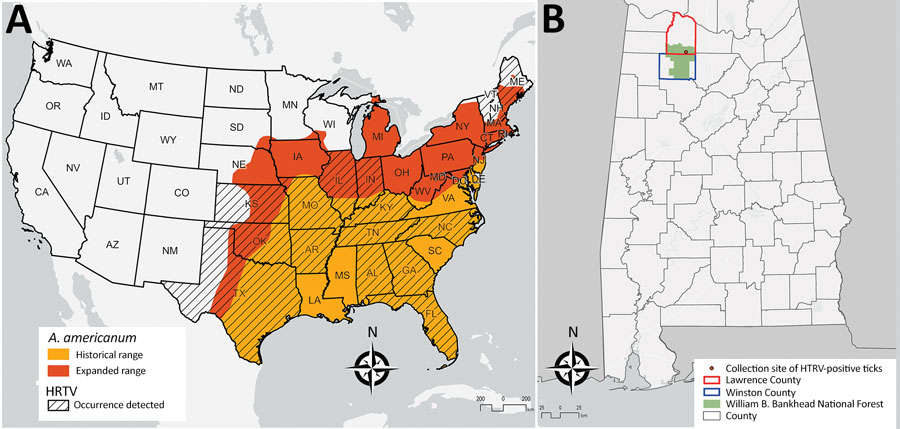Volume 26, Number 8—August 2020
Research Letter
Heartland Virus in Lone Star Ticks, Alabama, USA
Figure

Figure. Distribution of HRTV and range of Amblyomma americanum ticks. A) Geographic distribution of Heartland virus, United States, 2009–2020 (1,2) with historical and expanded range of A. americanum ticks adapted from (4). B) Location of the William B. Bankhead National Forest within Lawrence and Winston Counties, Alabama, and collection site of the HRTV-positive A. americanum nymphs. All maps were created by using ArcGIS Pro 2.5 (ESRI, https://www.esri.com/en-us/home). HRTV, Heartland virus.
References
- Centers for Disease Control and Prevention, National Center for Emerging and Zoonotic Infectious Diseases, Division of Vector-Borne Diseases. Heartland virus disease (Heartland): statistics & maps. 2018 Oct 22 [cited 2020 Feb 11]. https://www.cdc.gov/heartland-virus/statistics/index.html
- Riemersma KK, Komar N. Heartland virus neutralizing antibodies in vertebrate wildlife, United States, 2009–2014. Emerg Infect Dis. 2015;21:1830–3. DOIPubMedGoogle Scholar
- Bosco-Lauth AM, Panella NA, Root JJ, Gidlewski T, Lash RR, Harmon JR, et al. Serological investigation of heartland virus (Bunyaviridae: Phlebovirus) exposure in wild and domestic animals adjacent to human case sites in Missouri 2012-2013. Am J Trop Med Hyg. 2015;92:1163–7. DOIPubMedGoogle Scholar
- Monzón JD, Atkinson EG, Henn BM, Benach JL. Population and evolutionary genomics of Amblyomma americanum, an expanding arthropod disease vector. Genome Biol Evol. 2016;8:1351–60. DOIPubMedGoogle Scholar
- Newman BC, Sutton WB, Wang Y, Schweitzer CJ, Moncayo AC, Miller BT. A standardized method for the construction of a tick drag/flag sampling approach and evaluation of sampling efficacy. Exp Appl Acarol. 2019;79:433–46. DOIPubMedGoogle Scholar
- Savage HM, Godsey MS Jr, Lambert A, Panella NA, Burkhalter KL, Harmon JR, et al. First detection of heartland virus (Bunyaviridae: Phlebovirus) from field collected arthropods. Am J Trop Med Hyg. 2013;89:445–52. DOIPubMedGoogle Scholar
- Hughes HR, Russell BJ, Lambert AJ. First complete genome sequences of Anopheles A virus of the genus Orthobunyavirus. Genome Announc. 2017;5:e01331–17. DOIPubMedGoogle Scholar
- Kumar S, Stecher G, Li M, Knyaz C, Tamura K. MEGA X: molecular evolutionary genetics analysis across computing platforms. Mol Biol Evol. 2018;35:1547–9. DOIPubMedGoogle Scholar
- Biggerstaff BJ. PooledInfRate, version 4.0: a Microsoft Office add-in to compute prevalence estimates from pooled samples. Fort Collins (CO): Centers for Disease Control and Prevention; 2009 [cited 2020 Apr 16]. https://www.cdc.gov/westnile/resourcepages/mosqsurvsoft.html
- Hevey MA, O’Halloran JA, Jagger BW, Staples JE, Lambert AJ, Panella AJ, et al. Heartland virus infection in a heart transplant recipient from the Heartland. Transpl Infect Dis. 2019;21:
e13098 . DOIPubMedGoogle Scholar
Page created: April 28, 2020
Page updated: July 19, 2020
Page reviewed: July 19, 2020
The conclusions, findings, and opinions expressed by authors contributing to this journal do not necessarily reflect the official position of the U.S. Department of Health and Human Services, the Public Health Service, the Centers for Disease Control and Prevention, or the authors' affiliated institutions. Use of trade names is for identification only and does not imply endorsement by any of the groups named above.